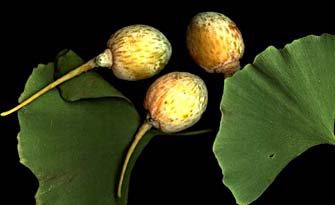



Ginkgoales: Systematics




Ginkgo biloba is the only extant species of the Order Ginkgoales. The name ginkgo comes from the Chinese yin-kuo (silver fruit); these characters are pronounced ginkyo in Japanese. The scientific name Ginkgo biloba comes from the fact that the leaves of the tree are notched and therefore appear to have two lobes. This species first became known to European botanists through Kaempfer, a surgeon employed by the Dutch East India Company. Ginkgo was discovered in 1690 and the first published description occurred in 1712.
Even now, scientists are still arguing where to place this unique order. Usually it is classified in one of three different ways, depending on which systematist you talk to. Some associate them with the conifers and the Cordaitales. Others think they belong in a clade with Peltaspermum and the cycads. Still others think that the Ginkgoales belong to a larger group with cycads, Peltaspermum and Callistophytales, variously arranged as a paraphyletic group below the platysperms. The reason why botanists have this much trouble placing the Ginkgoales is because ginkgoes have reproductive structures similar to that of the cycads and vegetative morphology of the conifers.

Ginkgo seeds : Like cycads, the seeds of Ginkgo are borne on highly modified leaves, whereas the seeds of conifers grow attached to modified branch systems.
As mentioned before, ginkgoes and cycads have similar reproductive systems. Both of these groups have motile sperm, which is a rarity amongst living seed plants. Both cycads and ginkgoes are dioecious, which means male and female reproductive structures are located on different plants. The mature Ginkgo seed is anatomically similar to its cycad counterpart. For example, its seed coat is divided into two parts, the sclerotes and scarcotesta. In comparison the conifers and the angiosperms have only a single undivided seed coat. The only difference is that in the ginkgoes, the vascular system consists of two bundles that extend throughout the innermost region of the integument. Furthermore, the cycad genus Nilssonicladus has a Ginkgo-like branching pattern.
The ginkgoes are tied to the conifers because they both exhibit axillary branching and have conifer-like primary xylem pitting. Both have woody trunks and woody roots as well as stipulate leaf bases. In short, both ginkgoes and conifers are trees with long internodes, whereas the cycads do not exhibit this mode of growth and have only unlengthened internodes.
How does one distinguish a Ginkgo from other gymnosperms? All ginkgoes (living and extinct) have fan shaped leaves. In fact leaves are the best way to recognize living and fossil ginkgoes.

Macleod, S.E. and Hills, L.V. 1991. Tithonian to pre-Albian plant macrofossils. v.70-71:23-24.
Taylor, Thomas N. and Edith L., 1993, The Biology of Fossil Plants, Prentice Hall, New Jersey, pp. 636-43.

